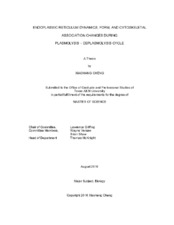| dc.description.abstract | Endoplasmic reticulum (ER), as the largest endomembrane system in eukaryotic cells, plays important roles in material synthesis and distribution. However, the underlying function of this amazing network in relation to the rest of the cell is largely unknown. In our studies, we use plasmolysis as a tool to study the shape and dynamics change of endoplasmic reticulum. During the process of plasmolysis, the portion of ER that remains in the protoplast goes through dramatic shape and dynamic change, which can be quantified using persistency mapping. Together with fluorescence recovery after photo-bleaching (FRAP) analysis, we found that accompanying the shrinkage of the protoplast and its retraction from the cell wall, the protoplast endoplasmic reticulum becomes more persistently cisternalized without changing its association with the cytoskeleton or its internal flow. On the other hand, as the protoplast pulls away from the inside surface of cell wall during plasmolysis, the volume of protoplast shrinks, while leaving parts of the ER and cytoskeletal components in the periplasmic region, forming Hechtian strands and the Hechtian reticulum that remain attached to the cell wall. The portion of ER that remains attached to the cell wall forms Hechtian strands and the Hechtian reticulum, and they have decreased internal flow and become more tubular shaped. For Hechtian reticulum specifically, it co-localizes with microtubule. 3D reconstruction models based on fluorescent confocal live images reveal the detailed structure and spatial organization of ER, plasma membrane and cell wall within the periplasmic region, as well as the ER – microtubule co-localization in the Hechtian reticulum. Interestingly, we found that within the periplasmic region, plasma membrane do not retract from the vicinity of the inner surface of the cell wall as protoplast is pulling away. Instead it forms a cover at the region where Hechtian reticulum forms. Together, our model suggests that the formation sites of Hechtian reticulum and Hechtian strands are potential cell wall – plasma membrane – ER anchor points. These anchor points may have important functions in ER morphological and dynamic control, thus contributing to biological processes from nutrition and growth to pathogen defense during the life span of plants. | en |


